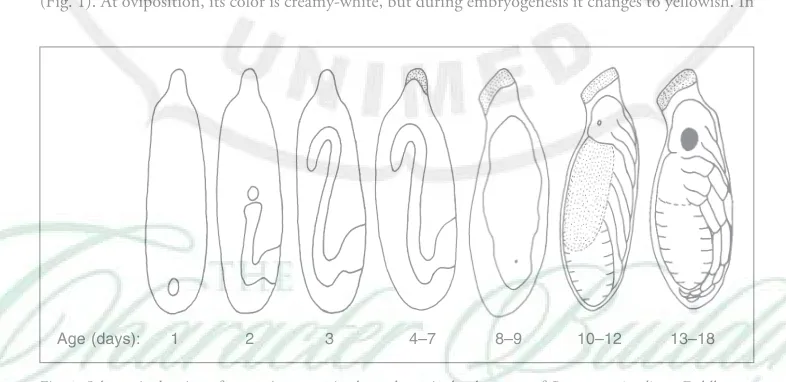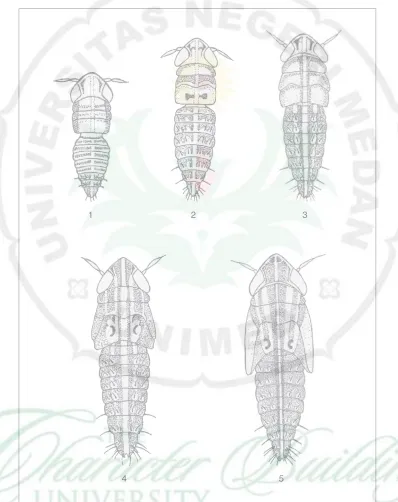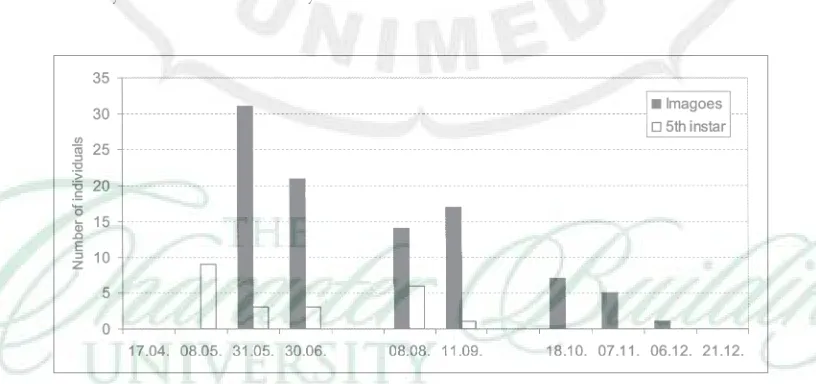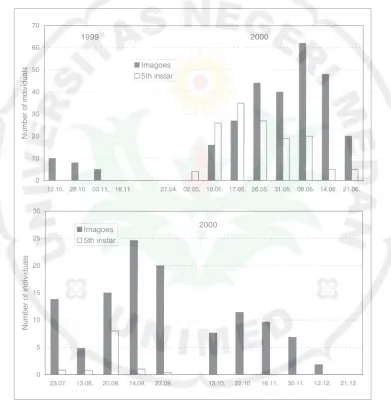Zeitschrift für Pflanzenkrankheiten und Pflanzenschutz Journal of Plant Diseases and Protection
112 (5), 497–507, 2005, ISSN 0340-8159 © Eugen Ulmer KG, Stuttgart
Studies on biology and population dynamics of the leafhopper
Psammotettix alienus Dahlb. (Homoptera: Auchenorrhyncha) as
vector of Wheat dwarf virus (WDV) in Saxony-Anhalt, Germany
Zur Biologie und Populationsdynamik der Zwergzikade Psammotettix alienus Dahlb. (Homoptera: Auchenorrhyncha) als Vektor des Wheat dwarf virus (WDV) in Sach-sen-Anhalt, DeutschlandB. M1, 2, W. W1, Silke M3, Maria G3, E. F3
1 Martin-Luther-University Halle-Wittenberg, Institute of Zoology, Hoher Weg 4, D-06099 Halle
(Saale), Germany
2 State University of Medan (UNIMED), Dept. of Biology-FMIPA, Medan-Estate, North-Sumatra,
Indonesia 20221
3 Martin-Luther-University Halle-Wittenberg, Institute of Plant Breeding and Plant
Protection-Virology, Emil-Abderhalden-Straße 27, D-06108 Halle (Saale), Germany
Received 11 August 2004; accepted 3 September 2004
Summary
Embryonic and nymph (larval) developments of the leafhopper Psammotettix alienus Dahlb. were studied on winter barley (Hordeum vulgare L.) under laboratory conditions (at 20 °C, 70–95 % RH and 18L/6D). Its population dynamics have been observed on winter barley in field since 1999. In the field, leafhoppers were caught with sweep-net and biocoenometer with aspirator from May to Novem-ber in 1999 and from April to DecemNovem-ber in 2000. Under the light microscope, seven stages of embryonic development can be distinguished. The nymph development consists of five instars. The duration of embryonic development was 18.3 days (range 16 ... 24 days), whereas nymph development lasted 32.4 days (range 26 ... 39 days). In this case, average duration of 1st instar, 2nd instar, 3rd instar,
4th instar and 5th instars were 5.9 days, 5.1 days, 5.6 days, 6.3 days and 9.4 days, respectively. In 1999,
imago (adult) leafhoppers could be observed in the field from the end of May to the second week of November, while in 2000, they were recorded from the second week of May until the third week of December. That means, the occurrence of leafhoppers as well as their activities as a vector of Wheat dwarf virus (WDV) in cereal crops in the region Saxony-Anhalt was earlier and longer in 2000 compared to 1999. In 1999 and in 2000, the peak population density was reached in a self-sown winter barley (stubble) field in mid-September with 43 and 25 individuals per m², respectively.
Key words: Psammotettix alienus Dahlb.; embryonic and nymph (larval) developments; population dynamics; Wheat dwarf virus (WDV)
Zusammenfassung
Larvalentwicklung 32,4 Tage (26 ... 39 Tage). Die Entwicklungszeit für L1 betrug 5,9 Tage, für L2
5,1 Tage, für L3 5,6 Tage, für L4 6,3 Tage und für L5 9,4 Tage. Im Jahre 1999 wurden adulte Tiere ab
Ende Mai bis zur zweiten Novemberwoche auf den Kontrollschlägen von Wintergerste gefangen. Im Jahre 2000 reichte der entsprechende Zeitraum von der zweiten Maiwoche bis zur dritten Dezember-woche. Damit setzte im letzgenannten Jahr die Besiedlung der Wintergerste durch P. alienus sowie dessen Aktivität als Vektor des Wheat dwarf virus (WDV) deutlich früher ein und hielt länger an als im Jahre 1999. Das Maximum der Populationsdichte wurde Mitte September in Ausfallgerste auf Stoppel-feldern erreicht. Im Jahre 1999 betrug die Maximaldichte 43 Individuen/m², im Jahre 2000 lediglich 25 Individuen/m².
Stichwörter: Psammotettix alienus Dahlb.; Embryonal- und Larvalentwicklung; Populationsdynamik; Wheat dwarf virus (WDV)
1 Introduction
The occurrence of the Wheat dwarf virus (WDV) on wheat and barley plants in Germany has been proven and confirmed (H and L 1994). The presence of this virus on barley, wheat, rye, oats, triticale, and maize in the region of Saxony-Anhalt has also been reported. In this case, WDV infects mainly barley, especially winter barley (M et al. 2000). It is known that WDV is transmitted by the leafhopper Psammotettix alienus Dahlb. to cereal plants and some wild grasses (V 1961, 1962; L and V 1991). Furthermore, our transmission experiments with this leafhopper have also confirmed that P. alienus caught in our region is able to transmit WDV to winter barley and winter wheat (M et al. 2001).
As a vector of WDV, no data are available concerning biology, development as well as population dynamics of P. alienus on winter barley, neither in Saxony-Anhalt nor in Germany.
In this paper, we report about the embryonic and nymph (larva) developments of P. alienus on winter barley under laboratory conditions as well as its population dynamics in crops of winter barley.
2 Materials and methods
2.1 Embryonic development
To study embryonic and nymph developments, individuals of P. alienus were artificially cultured. Since 1999, we have succeeded to establish cultures of P. alienus caught from crops of winter barley in Micheln in the region of Köthen (Saxony-Anhalt). Methods according to M (1973) and W (1985) were used to rear the culture. Furthermore, methods described by W (1985) and S (1996) supported the investigation of the embryonic development. In this case, fertilized females were placed on winter barley in glass tubes of 30 × 13 cm. After 4 h, the leafhoppers were collected and then placed again on other winter barley plants in glass tubes. The leaves of winter barley, where leafhoppers were placed, were directly observed under the light microscope for finding the eggs. They were isolated from the leaves and then kept in sterilized tap water in a Petri dish under laboratory conditions (at 20 °C, 70–95 % RH, 18L/6D). These eggs were checked until hatching.
2.2 Nymph development
This was done based on the method published by G and V (1997). To separate different instar stages, the method according to W (1975, 1978) was used.
2.3 Population dynamics
The population dynamics of the leafhopper P. alienus were studied in 1999 and 2000. Hoppers were sampled from May to November 1999 in Freist (Saalkreis region) and in Micheln (region of Köthen), and from April to December 2000 in Freist and in Zscherben in the vicinity of Halle (Saale), Saxony-Anhalt.
The sampling was made with a sweep-net (diam. 30 cm) and/or a biocoenometer (diam. 57 cm) (W 1975). Sweep-nets were principally used for catching hoppers in winter barley crops still growing until nearly harvesting (from April/May to June/July), while catches by means of a biocoenometer catches were made in stubble as well as in self-sown winter barley fields (from July/August to Septem-ber) as well as in newly sown winter barley fields (from October to November/DecemSeptem-ber). For each sampling, 400 swing slaps with a sweep-net or 20 points (altogether 5 m²) with a biocoenometer were needed. The middle, the western and the eastern side as well as the head top part of the field were examined. It was carried out at good weather with temperatures between 20 to 28 °C (except in the beginning of spring or in the end of autumn).
In the laboratory, the hoppers were separated and identified. The imago (adult) individuals of P. alienus were determined using the taxonomic keys of R (1952) and O (1983). Samples of the 5th larval collected in the field were compared for identification with specimens of the 5th larval of P. alienus reared in the laboratory.
3 Results
3.1 Embryonic development
The form of P. alienus egg is ellipsoidal with the anterior pole pointed and the posterior one rounded (Fig. 1). At oviposition, its color is creamy-white, but during embryogenesis it changes to yellowish. In
Fig. 1. Schematic drawing of successive stages in the embryonic development of Psammotettix alienus Dahlb. 1st day: egg is in the blastoderm stage and symbiont-harboring organs appear as a circle at the posterior pole; 2nd day: the germ anlage is moved by anatrepsis (invagination) into the yolk system; 3rd day: the greater extension of the germ band and appears as S-shaped; 4th–7th days: the greatest extension egg size is achieved as a result of water absorption; 8th–9th days: embryo before katatrepsis; in this case, the eye spot appears at the posterior pole; 10th– 12th days: embryo after katatrepsis; 13th–18th days: head, thorax, abdomen segment as well as legs can be clearly defined and the embryo is ready to hatch from the egg.
addition, the egg size changes during embryogenesis. The size at oviposition is 0.92 ... 0.99 mm × 0.18 ... 0.22 mm, but before hatching 0.93 ... 1.07 mm × 0.26 ... 0.3 mm. Thus, width increases more than length. The increase in width may reach nearly 37 %, length only 7 %.
Testing 201 eggs, the average duration of embryonic development was 18.3 days (range 16 ... 24 days). Using a light microscope, the embryonic development of P. alienus can be divided into seven stages (Fig. 1).
3.2 Nymph development
In agreement with other members of the Auchenorrhyncha, the nymph development of the leafhopper P. alienus encloses five instars (Fig. 2).
These instars can be distinguished from each other by the character of the total body length, front body length, the length of mesonotal with its wingpads, head width, pronotum width, number of chaetotaxy on each side of the tergites III-IX and coloration pattern.
According to its color pattern, the nymphs of P. alienus can appear in two forms, i. e., light and dark form. Both forms can be found in laboratory cultures as well as in the field.
In descriptions concerning instars of P. alienus, especially light form is well documented by G - and V (1997).
On winter barley at 20 °C, 70–95 % RH, 18L/6D, the average duration of nymph development was 32.4 days (range 26 ... 39 days). In this case, the average duration of first instar, second instar, third instar, fourth instar and fifth instar were 5.9 days, 5.1 days, 5.6 days, 6.3 days and 9.4 days, respectively (Table 1). This means, the average duration of development from egg to imago of P. alienus was about 51 days. Including the time of pre-oviposition of the imago about 7 days, the life cycle from egg to egg of this leafhopper was about 58 days.
3.3 Population dynamics
3.3.1 Observations in the year 1999
The population dynamics of P. alienus in two areas of Saxony-Anhalt, Germany, are described in Figure 3 and Figure 4. In 1999, the imagines of the first generation of P. alienus could be first observed at the end of May in Freist, but only in mid-June in Micheln. In Micheln, documentated in Figure 3, more nymphs of the fifth instar were netted than imagines at that time. Concluding from this result, the nymph development of the first generation was not finished in this area. In the first week of August, after winter barley crops had been harvested, the fifth instar and imago of the second generation of P. alienus could be caught in stubble and self-sown barley fields in Freist and also in Micheln. In October, only imago stage was collected in crops of newly sown winter barley, both in Freist and Micheln. The same results were obtained until the time of disappearance of hoppers in the second week of November. From the mid-November, imagines of the second generation could be found no longer on newly sown fields. After the first week of November, in both investigated areas colder weather conditions set in with temperatures below zero and snow. As a result of that, the leafhopper died. Therefore, in the year 1999, the hopper P. alienus occurred in winter barley fields only until the second week of November.
The abundance of the first generation of P. alienus was lower than that of the second. For example, in Micheln, the abundance of the fifth instar and imagoes of the first generation recognized in June in the tested barley field was only 142 individuals per 400 swing slaps with a sweep-net. However, in mid-September, the second generation established in the self-sown barley field reached 1222 individuals. Furthermore, in comparison with Freist, the abundance of P. alienus in Micheln was significantly higher.
Fig. 2. Nymphal stages of Psammotettix alienus Dahlb.
1: first instar; 2: second instar; 3: third instar; 4: fourth instar; 5: fifth instar (from G and V 1997, modified).
1 2 3
Table 1. Mean length (days) of developmental stages of Psammotettix alienus Dahlb. (20 °C, 70–95 % RH, 18L/6D)
Development stage Average (x–) Range
Embryonic development (n= 201) 18.3 Γ 1.5 16 … 24
Nymph development
1st instar (n = 62) 5.9 Γ 0.5 5 … 7
2st instar (n = 58) 5.1 Γ 0.7 4 … 6
3rd instar (n = 58) 5.6 Γ 0.8 4 … 7
4th instar (n = 58) 6.3 Γ 0.8 5 … 8
5th instar (n = 55) 9.4 Γ 0.6 8 … 11
Total of nymphal development 32.3 26 … 39
Total of emb. and nymphal developments 50.6 42 … 63
Imago pre-oviposition c. 7
Egg to egg c. 58 49 … 70
3.3.2 Observations in the year 2000
The phenology of P. alienus in the course of the year 2000 as well as its population development are shown in Figure 5 and Figure 6. In Freist, in crops of growing winter barley nymphs of the fifth instar of the first generation could be caught in the beginning of May. Two of them were maintained under laboratory conditions at +20 ± 2 °C. After 4 days, the first one hatched to imago male, and after 6 days, the second one hatched to imago female. Aedagus of imago male was observed under a light microscope and proved to be P. alienus Dahlb. Therefore, in Freist, imagoes of the first generation appeared obviously in the second week of May.
Fig. 4. Abundance of Psammotettix alienus Dahlb. in crops of growing winter barley (May) (number of individuals/ 400 swing slaps), in stubble and self-sown cereal fields (July to September) (number of individuals/m²) as well as in crops of newly sown winter barley (October to November) (number of individuals/m²), recorded in Freist in the year 1999.
The investigations in Zscherben provided corresponding results. Likewise, in growing winter barley fields, nymphs of the fifth instar were found in the first week of May, their imagines (adults) in the second week.
In our opinion, in the year 2000 with its warm weather after the first generation, two further generations occurred, altogether three generations. Its second generation could be recognized by the nymphs of the fifth instar caught in maturing winter barley as well as in stubble and self-sown barley fields in mid-June and at the end of July. The fifth instars of the third generation were netted in self-sown barley in the third week of September (Fig. 6). In the third week of December 2000, imagines of Fig. 6. Abundance of Psammotettix alienus Dahlb. in crops of newly sown winter barley (October to November 1999) (number of individuals/m²), in crops of growing and maturing winter barley (April to June 2000) (number of individuals/400 swing slaps), in stubble and self-sown cereal fields (July to September 2000) (number of individuals/m²) as well as in crops of newly sown winter barley (October to December 2000) (number of individuals/m²), recorded in Zscherben (near Halle).
1999 2000
P. alienus could no longer be found in newly sown barley. Probably, the temperatures decreased considerably to below zero after mid-December and caused the death of leafhoppers. Therefore, in difference to 1999, in the year 2000, the occurrence of P. alienus in winter barley was longer. With other words, its appearing was earlier and its disappearing was later.
With regard to the abundance of P. alienus in the year 2000, the first generation was lower than its second generation. The abundance reached the peak in mid-September, both in Freist and Zscherben. In Zscherben compared to Freist, all investigations of the year 2000 showed a higher abundance of P. alienus. For example, the results received by means of biocoenometer in newly sown winter barley from October 2000: 11 individuals/m² were found in Zscherben, but only 7 individuals/m² in Freist. The results throughout the year 2000 in comparison with such of year 1999, both in Zscherben and Freist a higher abundance of P. alienus was observed in the year 2000. However, the highest abundance of P. alienus could be found out in Micheln in the year 1999.
4 Discussion
P. alienus overwinters in the egg stage. In this connection, our result pointed out that 89 % to 100 % of the females caught from October to November 1999 in newly sown winter barley were loaded with eggs (M et al. 2000). This means during autumn females laid eggs on newly sown winter barley and other plants for overwintering. In addition, our investigations concerning overwintering of that hopper under natural conditions have shown that eggs, which were laid at the end of August 2000 or during the next months, do not reach hatching immediately. Especially the shorter day length causes the dormancy and hatching of eggs only in the spring of the following year.
As an ectoterm insect, the efficiency of embryonic and nymph developments of P. alienus is influenced by environmental factors especially weather conditions. Such factors determine the length of embryonic and nymph development stages, first appearance of imagines and the duration of their presence in the field as well as the number of generations per year. The temperature is an important factor and has a direct effect on the life of the hopper. Differences in temperature during 1999 and 2000, for example, have caused differences in appearance and disappearance of P. alienus in crops of winter barley as well as its generation number. In the year 2000 with its warm weather, imagines of P. alienus appeared already in the second week of May and they disappeared only at the end of autumn. That means, the actual occurrence of this hopper with its nymph in winter barley fields reached from mid-April until the third week of December. In that year, three generations of P. alienus were present, but in 1999 only two. In the last-mentioned year, the first imagines could be found at the end of May. The imagines of the second generation disappeared after the first week of November. Therefore, the occurrence of this hopper in 1999 with its nymph in spring was from the early in May until the second week of November.
Our observations concerning the occurrence of P. alienus in crops of barley were different from those of S et al. (1996). They found imagines of P. alienus from the early June to the end of October. Therefore, in the years 1999 and 2000, the periods of occurrence of P. alienus were obviously longer.
The duration of presence of P. alienus is to take into account in order to get right the activities of this hopper as vector of WDV. P. alienus and its nymphs acquire and transmit this virus from one plant to others in the same area, but also from one area to other areas.
According to V and C (2000) and our results have shown, too, that the instar stages (nymph) of P. alienus are also able to be a vector of WDV. That means, in 2000, nymph of P. alienus could act as vector of WDV in growing winter barley since April, whereas in 1999, since May. As a result of this, in the year 2000, more infections were possible than in the year 1999. For this reason, a higher percentage of WDV-infected barley plants was to be expected in the year 2000. This presump-tion was supported and confirmed by the result of our investigapresump-tions. At the beginning of summer 2000, we could detect 17.8 % (0.7 ... 34.7) newly WDV-infected winter barley plants, in 1999 however, it were only 5 % (0.0 ... 16.7).
discovered. Therefore, concerning the stages of the life cycle of P. alienus which are responsible for virus acquiring and transmitting, it is to conclude that the secondary infection in spring and summer is caused by nymph and imago stages, but the primary infection of newly-sown winter barley in October/ November and sometimes until December such as in 2000, on the other hand, is carried out only by imago stage.
In our studies, the peak abundance of P. alienus was recorded in self-sown cereal fields. Meanwhile, according to M et al. (2001), the incidence of WDV in such crops was extremely high. Self-sown cereals are important for maintenance of populations of P. alienus and such crops serve at the same time as reservoir of WDV. This connection is of great importance, because leafhoppers of this generation are responsible for WDV-infections of newly sown winter barley plants. Therefore, the removal of stubble and self-sown cereal fields is an important measure to diminish the hopper populations and to reduce WDV-infections in crops of newly sown winter cereals. According to our observations from the year 2000 in the region of Zscherben, ploughing carried out shortly after harvesting reduced considerably the hopper abundance. The removal of cereal stubbles and self-sown cereals by using herbicides for chemical top killing (Roundup) is also helpful. For example, a farm from Micheln had obtained great success with it in October 1999.
Literature
G, A., E. G. V: Postembryonic development and biology of Psammotettix alienus (Dahlbom) (Homoptera: Cicadellidae) under laboratory conditions. – Boll. Zool. Agr. Bachic. Ser. II, 29, 65–80, 1997.
H, W., D. E. L: Nachweis des Wheat dwarf virus in Deutschland. – Nachrichtenbl. Dt. Pflanzenschutzd. 46, 105–106, 1994.
L, K., J. V: A possible barley-adapted strain of wheat dwarf virus (WDV). – Acta Phytopath. Entomol. Hung. 26, 175–180, 1991.
M, B., W. W, S. M, M. G, E. F: Vorläufige Ergebnisse zur Populationsdynamik der Zikade Psammotettix alienus (Dahlbom 1851) (Homoptera: Auchenor-rhyncha), einem Vektor für Wheat dwarf virus (WDV). – Mitt. Biol. Bundesanst. 376, 557, 2000. M, S., E. F, B. M, M. G, W. W: Investigations on the ecology of Wheat dwarf virus (WDV) in Saxony-Anhalt, Germany. – IX Conference on virus diseases of Gramineae in Europe, Central Science Laboratory, York, UK 21–23 May 2001, Abstract. M, S., B. M, M. G, W. W, E. F: Zur Ökologie des Wheat dwarf
virus (WDV) in Sachsen-Anhalt. – Mitt. Biol. Bundesanst. 376, 319, 2000.
M, H. J.: Erfahrungen bei der Haltung und Aufzucht von Zikaden (Homoptera: Auchenorrhyncha) für ökologische Untersuchungen. – Wiss. Z. Friedrich-Schiller-Univ. Jena, Mat.-Nat. R. 22, 643– 665, 1973.
O, F.: The Auchenorrhyncha (Homoptera) of Fennoscandia and Denmark. Part 3: The family Cidadellidae: Deltocephalinae, Catalogue, Literature and Index. – Scandinavian Science Press LTD, Copenhagen, pp. 813–815, 1983.
R, H.: Homopteres Auchenorhynques. II (Jassidae). – Faune de France 57. Paul Lechevalier, 12, Rue de Tournon (VIe), Paris, 242–243, 1952.
S, H., R. E, W. W: Beiträge zur Insektenfauna Ostdeutschlands: Homoptera-Auchenorrhyncha (Cicadina) (Insecta), Teil IV: Unterfamilie Deltocephalinae. – Faun. Abh. Staat. Mus. Tierkd. 20, 153–256, 1996.
S, H.: Untersuchungen zur Autökologie von Zikaden (Homoptera, Auchenorrhyncha) unter besonderer Berücksichtigung des Wasserangebotes im Verlauf der Embryogenese. – Ph. D. thesis, University of Halle-Wittenberg, 1996.
V, J.: Wheat dwarf virus disease. – Biol. Plant. 3, 228–233, 1961.
V, J.: Some new findings on wheat dwarf virus. – Plant Virology, Proc. of 5th Confer. of Czechoslov. Pl. Virol. 331–334, 1962.
W, S.: Larvenformen mitteleuropäischer Euscelinen (Homoptera, Auchenorrhyncha). – Zool. Jb. Syst. 102, 241–302, 1975.
W, S.: Larvenformen mitteleuropäischer Euscelinen (Homoptera, Auchenorrhyncha) Teil II. – Zool. Jb. Syst. 105, 102–130, 1978.
W, W.: Eine quantitative Keschermethode zur Erfassung der epigäischen Arthropoden Fauna. – Entomol. Nachr. 8, 123–128, 1975.




